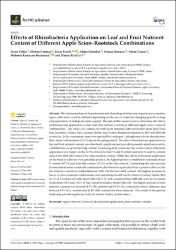| dc.contributor.author | Ercan Yildiz | |
| dc.contributor.author | Mehmet Yaman | |
| dc.contributor.author | Sezai Ercisli | |
| dc.contributor.author | Ahmet Sumbul | |
| dc.contributor.author | Osman Sonmez | |
| dc.contributor.author | Adem Gunes | |
| dc.contributor.author | Mehmet Ramazan Bozhuyuk | |
| dc.contributor.author | Darius Kviklys | |
| dc.date.accessioned | 2023-06-19T08:04:07Z | |
| dc.date.available | 2023-06-19T08:04:07Z | |
| dc.date.issued | 2022 | tr |
| dc.identifier.citation | Yildiz, E.; Yaman, M.;Ercisli, S.; Sumbul, A.; Sonmez, O.;Gunes, A.; Bozhuyuk, M.R.; Kviklys,D. Effects of RhizobacteriaApplication on Leaf and FruitNutrient Content of Different AppleScion–Rootstock Combinations.Horticulturae 2022, 8, 550. https://doi.org/10.3390/horticulturae8060550 | tr |
| dc.identifier.uri | https://hdl.handle.net/20.500.12418/13711 | |
| dc.description.abstract | The plant pomological characteristics and physiological behaviors of genotypes in mod-ern apple cultivation could be different depending on the use of rootstock, changing growth ecologyand application of biological control agents. The aim of this research was to determine the effects ofrhizobacteria application on leaf and fruit nutrient contents in different apple scion–rootstock com-binations. This study was carried out with seven standard cultivars (Scarlet Spur, Red Chief, Fuji,Jeromine, Galaxy Gala, Granny Smith, and Golden Reinders) budded on M.9 and MM.106 root-stocks. In the experiment, trees were sprayed by a nitrogen + phosphorus solvent rhizobacteria threetimes, with an interval of 15 days in the spring period. The effect of rhizobacteria application on leafand fruit nutrient contents was statistically significant and provided generally significant positivecontributions, except for leaf Mg content. Comparing both rootstocks, the positive effect of bacterialapplication was higher on the M.9 rootstock for leaf N and B content and fruit N and Fe content,and on the MM.106 rootstock for other nutrient content. While the effects of bacterial application onthe basis of cultivars were generally positive, the highest positive contribution was made in leaf Pcontent (10.7%) and fruit Mn content (32.1%) of the Fuji cultivar. Considering the total increase innutrients in scion–rootstocks combination, rhizobacteria application had a positive effect on the leafnutrient contents in Golden Reinders/MM.106, but not leaf K content. The highest increases in leavesof scion-rootstock combinations were determined as 4.0% in N content in Granny Smith/M.9, 14.1%in P content in Scarlet Spur/MM.106, 7.1% in K content in Fuji/MM.106, 4.4% in Ca content in Je-romine/M.9, and 14.0% in Mg content in Granny Smith/MM.106. The highest increase in fruit nutri-ent contents was between 4.9% (N content) and 13.5% (Ca content) for macro elements, and between9.5% (Cu content) and 41.8% (Mn content) for microelements. The results of the present study mayprovide significant leads for further studies on this subject. | tr |
| dc.description.sponsorship | Erciyes UniversityScientific Research Projects Department (Project No: FCD-2020-9930) | tr |
| dc.language.iso | eng | tr |
| dc.relation.isversionof | 10.3390/horticulturae8060550 | tr |
| dc.rights | info:eu-repo/semantics/openAccess | tr |
| dc.subject | apple cultivars; rootstock; rhizobacteria application; plant nutrient contents | tr |
| dc.title | Effects of Rhizobacteria Application on Leaf and Fruit NutrientContent of Different Apple Scion–Rootstock Combinations | tr |
| dc.type | article | tr |
| dc.relation.journal | Horticulturae | tr |
| dc.contributor.department | Suşehri Timur Karabal Meslek Yüksekokulu | tr |
| dc.identifier.issue | 8 | tr |
| dc.identifier.endpage | 563 | tr |
| dc.identifier.startpage | 550 | tr |
| dc.relation.publicationcategory | Uluslararası Hakemli Dergide Makale - Kurum Öğretim Elemanı | tr |















